Chances are when you think about physics, this may be one of the first things that come to mind! Forces, velocity, displacement, etc.: these are probably the words and terms that pop up in your head when you hear the word physics!
Similar to other physics topics, we can already have a good idea of what we’re trying to study based on the name itself: the prefix “-kine” refers to motion, which makes sense as kinematics is the branch of physics that studies the motion of objects.
After finishing this guide, you’ll have a basic understanding of various topics in kinematics which you can delve more into in detail with our individual study articles. Let’s get started!
Kinematics on the MCAT: What You Need to Know
Topics on kinematics will be tested on the Chem/Phys section of the MCAT and can appear both as passage based and fundamental discrete questions.
If you save this section for a little later in your prep, don’t feel worried! We calculated that you can probably expect around 2-3 questions that can possibly come up!
Introductory physics accounts for 25% of the content covered in the Chemical and Physical Foundations of Biological Systems.
Important Sub-Topics: Kinematics
This portion of MCAT physics content review is probably the one most math heavy in regards to trigonometry (ewww…). There will be just a few trigonometric concepts that will come up when covering kinematics.
However, these concepts are fairly easy to comprehend and recall (if you’ve taken a little trigonometry before)! Additionally, we’ll always try to keep the content of these outside trigonometric concepts to the bare essentials in terms of what you need to know.
1. Mathematics of Vectors and Scalars
If you’ve watched the movie Despicable Me, you won’t have a hard time remembering what vectors are. Just like the main villain, vectors are quantities that have both direction and magnitude which is usually represented by an arrow. Scalars are quantities that only have magnitude. Consider the example below!
The arrow shown on the left has a length of 6 (the magnitude) and is pointed to the right (the direction). The line shown on the right only has a length of 6 (magnitude), but we have no information about its direction.
The difference between vector and scalar quantities is even better pronounced when you apply them to examples. For instance, values like displacement and velocity are vector quantities while distance and speed are the scalar equivalents.
A good way to think about vectors is that they have both an x and y-component. This is where having some basics in trigonometry can be helpful: by making a right triangle, we can use some basic trigonometric equations.
Vectors and scalar quantities can both be added and subtracted. Usually, the MCAT will focus on vector mathematics because they want to test your ability to take into account the vector direction.
An easy way to add vectors is to simply add the x and y components of the vectors together to get the resultant vector.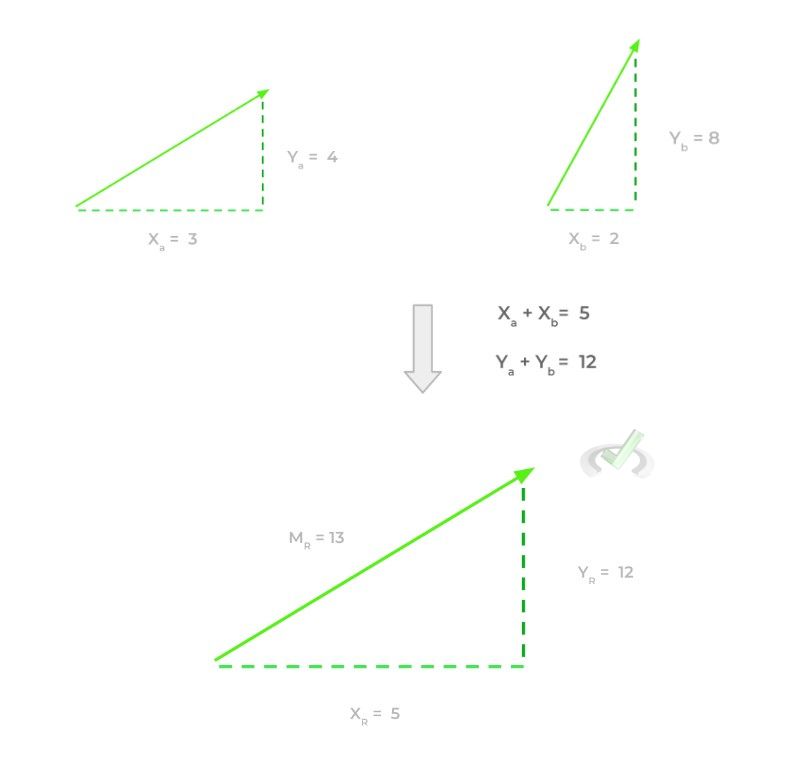
As shown, we simply add the individual x and y components of the individual vectors in order to get the resultant vector. Conversely, to get the resultant vector from subtraction, we simply subtract the x and y components from the individual vectors.
(Coming Soon!) Full Study Notes : Mathematics of Vectors and Scalars
For more in-depth content review on mathematics of vectors and scalars, check out these detailed lesson notes created by top MCAT scorers.
2. Displacement, Distance, Velocity, and Speed
Now we can actually get into applying the vector and scalar quantities to more applicable real life examples. Let’s first start with displacement and distance as they both relate to the position.
Displacement refers to the total amount of change in the position of an object from a starting point. Distance refers to the total distance that an object traveled, regardless of how far it is from its original position. As mentioned above, displacement and distance are vector and scalar quantities, respectively.
Let’s look at a classic example to get a better understanding: suppose you start at point X1, run in a circle with a circumference of 3 meters, and stop at point X1. The total distance you traveled is 3 meters; however, your displacement is 0 meters because there was no change in your starting and final position.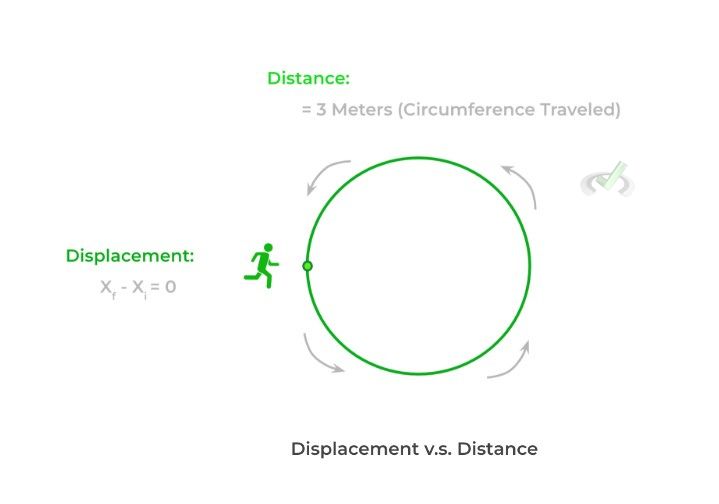
Similarly, velocity and speed are also related concepts to displacement and distance. Velocity is simply the average displacement of an object per unit of time, usually in seconds while speed refers to the average distance traveled per unit of time.
Just like displacement and distance, velocity and speed are also vector and scalar quantities, respectively. The calculations below take the values from the example above!
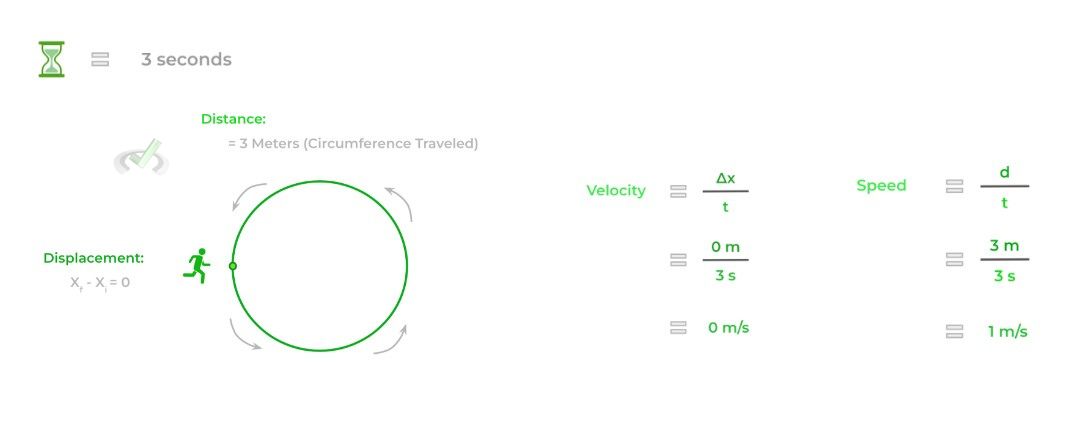
(Coming Soon!) Full Study Notes : Displacement, Velocity, and Speed
For more in-depth content review on displacement, velocity and speed, check out these detailed lesson notes created by top MCAT scorers.
3. Acceleration and Motion
This term can sometimes be a little confusing at first sight, but is easier when broken down into an example! Acceleration refers to how fast an object’s velocity is changing. When an NBA player like Zach Lavine changes his velocity to drive down the lane for a slam dunk, he accelerates to get that dunk (and hopefully, a poster!).
The most common encounter of acceleration on the MCAT is gravitational acceleration, which is the acceleration of an object as it falls to the ground due to gravity. Specifically, this value is 9.8 m/s2. Let’s give an example of acceleration to get a better understanding.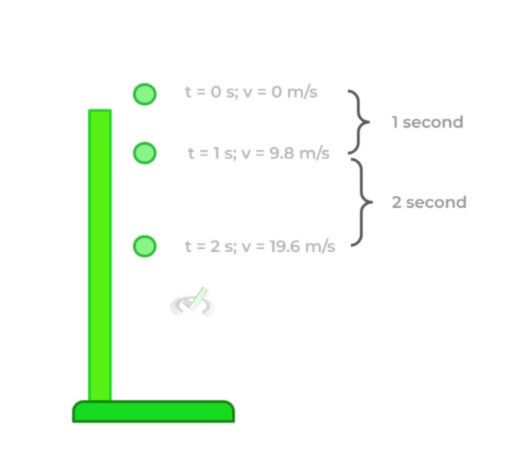
Suppose you drop a ball down from a cliff. 1 second after the ball drops, the ball is traveling at a velocity of 9.8 m/s2. This is because it started at a velocity of 0 at 0 seconds and accelerated (change velocity) via the gravity acceleration constant. Following this, 2 seconds after the ball drops, the ball is now traveling at a velocity of 19.6 m/s.
A lot of the tested kinematic equations that deal with motion on the MCAT deal with constant acceleration, where velocity is changing at a constant rate. A couple of these equations are listed below!
The left equation can be used to solve for a final velocity of an object, while the right equation can be used to determine the displacement of an object!
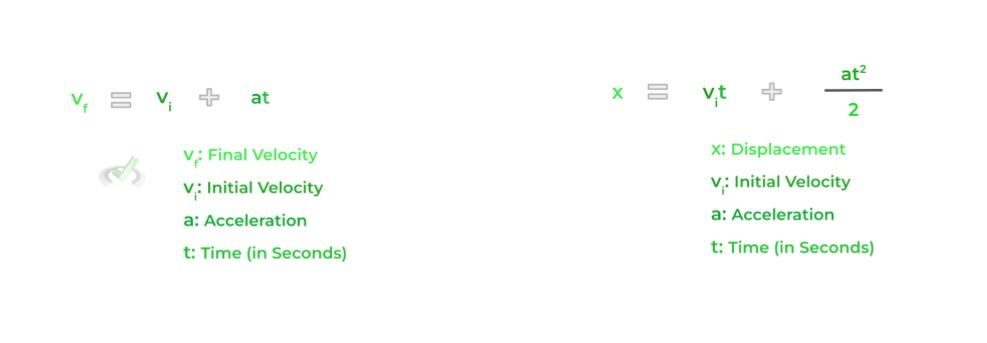
The 2 most common types of motions with constant acceleration that the MCAT will test is linear and projectile motion. The only difference between the 2 is the dimensions that are used: linear motion deals with one dimensional motion (only x or y) while projectile motion deals with both dimensions (x and y).
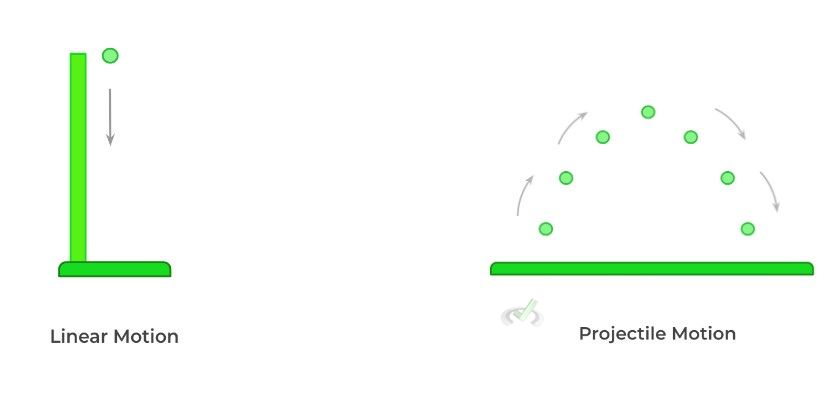
(Coming Soon!) Full Study Notes : Acceleration and Motion
For more in-depth content review on acceleration and motion, check out these detailed lesson notes created by top MCAT scorers.
4. Types of Forces
Before getting into the different types of forces that you’ll encounter on the MCAT< let’s first give a basic definition of what a force is! Force is often described as a pushing or pulling interaction between objects given in the SI units, newtons.
One type of force that will for sure come up on the MCAT is gravitational force, specifically in the context of weight. From here, we can differentiate between the values of mass and weight.
Mass refers to the total amount of matter within an object while weight is the gravitational force acting on an object’s mass, as given by the equation below. Notice the similarity between this equation and Newton’s second law as we’ll discuss in the next section!
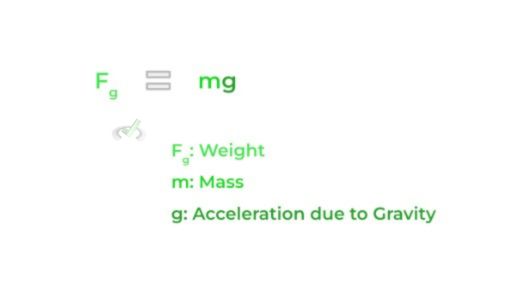
Another type of force you’ll encounter on the MCAT is frictional force which is the force that opposes the motion of an object. These forces can be further divided into static friction and kinetic friction.
As indicated by the name, static friction is the frictional force on a stationary object where it prevents it from moving. Conversely, kinetic friction is the frictional force that opposes a moving object!
A good way to think about the relationship between the 2 types of frictional force is that the force that causes motion on the object must first surpass the maximum static frictional force to experience the kinetic frictional force.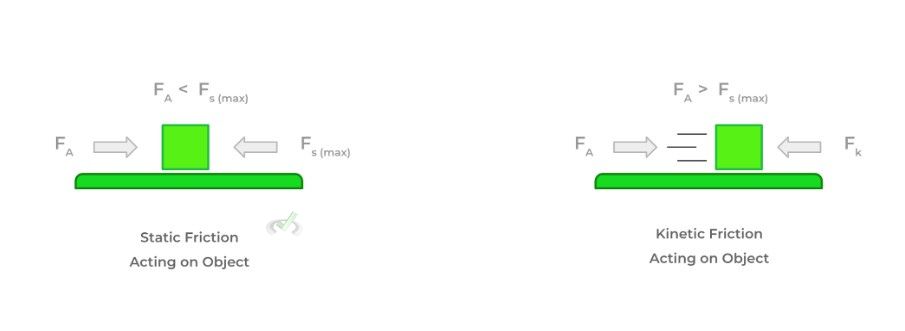
(Coming Soon!) Full Study Notes : Types of Forces
For more in-depth content review on types of forces, check out these detailed lesson notes created by top MCAT scorers.
5. Newton’s Laws
Just like with thermodynamics and other physics concepts, we can attribute the various observations in kinematics to 3 main laws, more specifically Newton’s Laws! The most common quote associated with Newton’s first law is that an object in motion (or at rest) will stay in motion (or at rest) until acted upon by an external force.
However, a more correct wording would be that an object at a constant velocity (or at rest) will stay at that constant velocity (or at rest) until acted upon by an unbalanced, external force.
A good example of the above definition is static friction! Suppose the maximum static friction force applied on an object at rest is 10 N and that there’s an applied force at 5 N.
Even though there’s an applied external force, there is still a balance which is why the object stays at rest. When a force of 11 N is applied, the net force is unbalanced and the object begins to move!
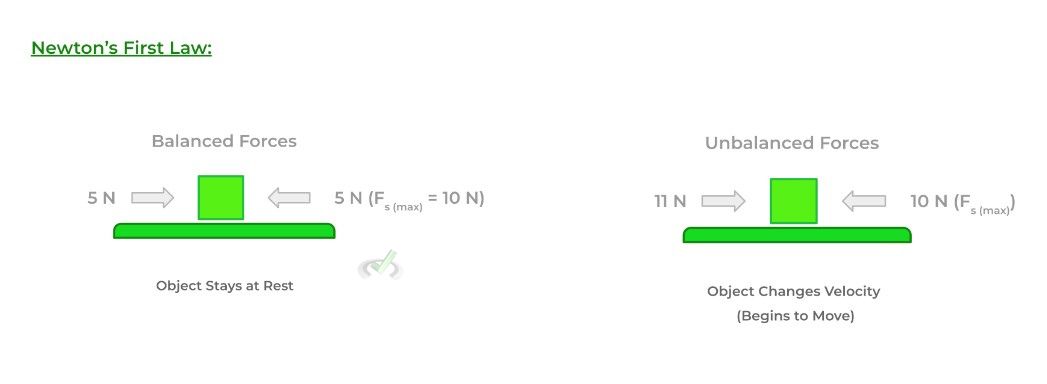
Likewise, a common iteration of Newton’s second law is that force is equal to mass times acceleration. More specifically, when a net force acts on an object, the object with mass will accelerate!
However, note that when the force is removed from the object, the object then moves at a constant velocity which accelerated too!
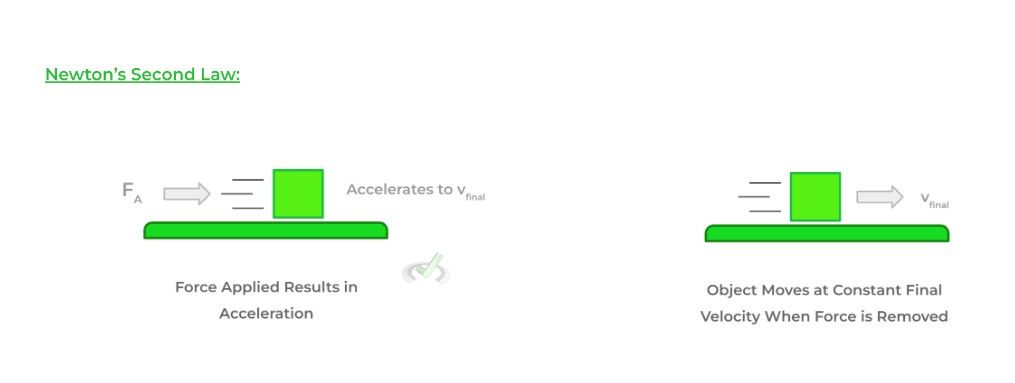
You’ve maybe heard Newton’s third law where people say, “for every reaction, there is an equal and opposite reaction.” To add to this great summation, we can say that object A exerts a force on object B, object B exerts an equal, opposing force on object A.
A great example of this is when you push up with your feet! In this process, you apply a force, FAB, on the ground. Based on Newton’s third law, the ground provides an equal force, FBA, on you, which actually causes you to push up!
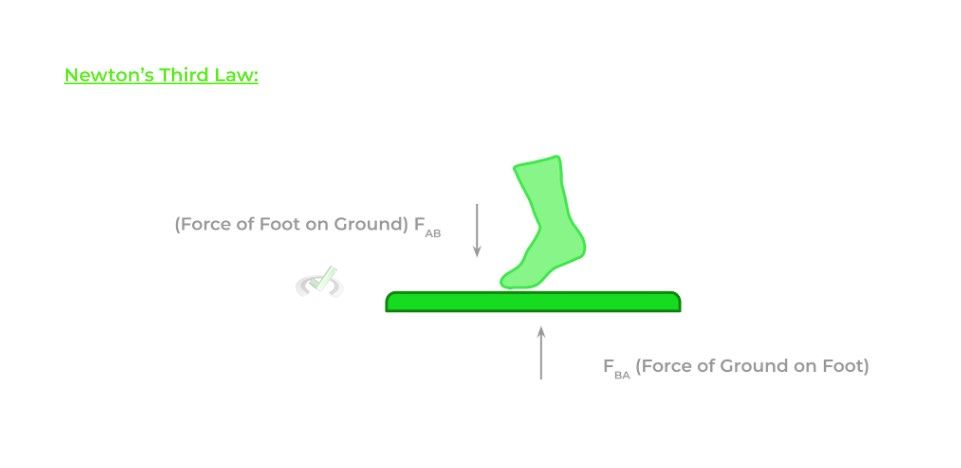
A common misconception that’s made is that because the forces are of equal magnitude, no motion can occur. However, it’s important to make the distinction that the forces act on different objects! It’s only when forces of equal magnitude and opposite direction act on the same system that no motion occurs!
(Coming Soon!) Full Study Notes : Newton’s Law
For more in-depth content review on newton's 3 laws of motion, check out these detailed lesson notes created by top MCAT scorers.
6. Mechanical Equilibrium
Though at first sight this term might seem scary, it’s actually fairly easy to comprehend when put into the context of examples. An important concept to understand with mechanical equilibrium is that it’s just an application of Newton’s first law. In this sense, mechanical equilibrium is when the net force acting on an object is 0.
In translational equilibrium, the motion in question does not involve rotation, rather focusing on linear and projectile motion. While an object can still be moving at a constant velocity in translational equilibrium, the MCAT will most likely test translational equilibrium when an object is not moving.
A great example of this is the 2 block pulley example shown below. Object A has a leftward static friction force which is matched equally by a rightward force which is caused by the force of gravity on object B. Likewise, the downward gravitational force of object B is matched equally by an upward force caused by the static friction force of object A.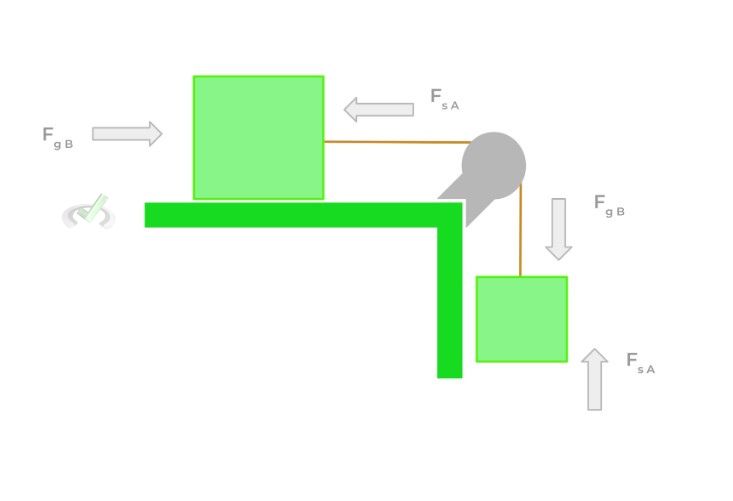
Conversely, rotational equilibrium occurs when the net force causing rotational motion on an object is 0. The force that causes rotational motion is specifically called torque (𝛕)! Similar to translational equilibrium, the MCAT will most likely test cases of rotational equilibrium where an object is not moving.
The most common example you’ll probably come across is a problem involving a seesaw with two objects placed on opposite sides of the fulcrum.
We’ll show you all how to calculate the torque in our specialized article but for now, just realize that when the opposing torques applied by each object are equal, the seesaw is balanced and doesn’t rotate!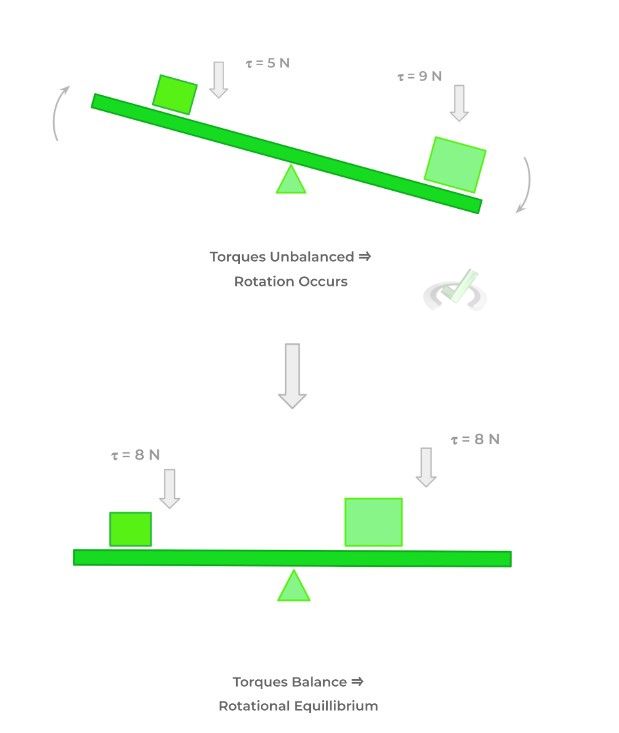
(Coming Soon!) Full Study Notes : Mechanical Equilibrium
For more in-depth content review on mechanical equilibrium, check out these detailed lesson notes created by top MCAT scorers.
Important Definitions and Key Terms
Below are some high yield definitions and key terms to refer to when reviewing concepts and ideas about kinematics!
Term | Definition |
|---|---|
Vectors | Quantities that have both direction and magnitude |
Scalar | Quantities that only have magnitude |
Displacement | Vector quantity which describes the change of the position of an object with respect to a starting position |
Distance | Scalar quantity which describes the total amount traveled in a pathway regardless of final position |
Velocity | Vector quantity which describes the average amount of displacement per unit time |
Speed |
Scalar quantity which describes the average amount of distance traveled per unit time |
Acceleration |
Vector quantity which describes the average change in velocity per unit time |
Force |
A pushing/pulling interaction between 2 objects |
Gravitational Force |
The force of gravity on an object which is calculated as the product of an object’s mass and the acceleration due to gravity |
Frictional Force |
The force which opposes the motion of an object |
Mechanical Equilibrium |
Occurs when the net force on an object is 0 and, as a result, stays at a constant velocity or at rest |
Additional FAQs - Kinematics on the MCAT
Are Kinematics on the MCAT?
Are Kinematic Equations Given on the MCAT?
How Do You Memorize Kinematic Equations for the MCAT?
What are the 4 Kinematic Equations – MCAT?
Additional Reading Links (Coming Soon!) – Study Notes for Kinematics on the MCAT
Additional Reading: Physics Topics on the MCAT:
- Circuits on the MCAT
- Electrostatics on the MCAT
- Fluids on the MCAT
- Atomic and Nuclear Phenomena on the MCAT
- Light and Optics on the MCAT
- Magnetism on the MCAT
- Thermodynamics on the MCAT
- Units and Dimensional Analysis on the MCAT
- Waves and Sound on the MCAT
- Work and Energy on the MCAT


 To help you achieve your goal MCAT score, we take turns hosting these
To help you achieve your goal MCAT score, we take turns hosting these